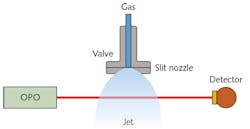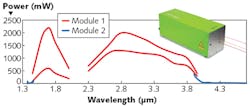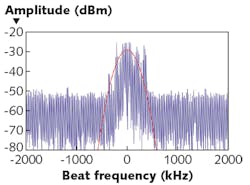Optical Parametric Oscillators: Ultrastable tunable laser sources serve IR spectroscopy for astrophysics
MATIN KAUFMANN, GUIDO W. FUCHS, and FRANK MUELLER
Chemistry in outer space is very much different from that on Earth. Understanding the chemical evolution of matter in space opens the door to knowledge about our origin and chemical destiny. The Laboratory Astrophysics group at the University of Kassel (Kassel, Germany), led by Thomas Giesen, is investigating molecules of astrophysical relevance. The group’s focus lies on improving the knowledge about the circumstellar and interstellar media and the evolution of matter in these extreme environments. This is achieved by using purely Earth-based experiments in combination with data collected from astronomical observations.
With the emergence of new high-spectral-resolution infrared (IR) telescopes, such as the Echelon-Cross-Echelle Spectrograph (EXES) in the Stratospheric Observatory for Infrared Astronomy (SOFIA), laboratory data in the IR have become increasingly important. Spectroscopic data collected in the laboratory is used to create extremely precise models of molecular structure and states. With these models, predictions of absorption wavelengths are made, allowing spectra recorded in astronomical observations to be interpreted. The resulting knowledge may lead to the detection of new molecules or isotopologues (molecules differing only in their isotopic composition) in space, and helps to disentangle the often-rich astronomic spectra.1
Infrared spectroscopy on molecules
Infrared spectroscopy is widely used in molecular physics as a tool to probe molecules via the transitions between their molecular states. At certain distinct wavelengths, the IR radiation interacts with the molecules, inducing changes in their rotational as well as their vibrational states.
Measuring the transitions between molecular energy levels yields information about fundamental molecular properties—for example, rotational and vibrational parameters. High-resolution and high-precision spectroscopy experiments are essential for obtaining the high-quality data needed for the understanding of molecular properties, which in turn is a requirement for creating reliable theoretical models for molecular structures and states. For instance, high-quality data leads to an improved understanding of astrophysical processes.
In a spectroscopic setup aiming for high precision, two components must be addressed. First, the experimental framework must prepare the molecules of interest in a way that allows high-resolution measurements (that is, with small intrinsic linewidths). Second, the spectroscopic portion of the experiment must support the desired resolution and precision—for instance, by using a radiation source with a narrow linewidth and high stability.
Experimental setup
For the University of Kassel experiments, pulsed supersonic jets are used to transport the molecules of interest into the gas phase and to cool them down to temperatures between 10 and 20 K, a common temperature range in cold interstellar molecular clouds (see Fig. 1).
In a typical simple absorption spectroscopy experiment, carrier gas pressurized to a few bars and containing the probe species is expanded through a slit nozzle into a chamber with a low background pressure (~10-2 mbar). IR laser light is guided through the chamber in front of the slit nozzle, penetrating the expanding gas, and is then guided onto an IR detector. Molecules in the jet expansion irradiated by IR light absorb the radiation—if its optical frequency (proportional to 1/wavelength) is in resonance with a molecular transition—and the IR detector records the reduced light intensity as the absorption signal.2
Continuous-wave (CW) optical parametric oscillator (OPO) technology is well suited for designing a radiation source for spectroscopy in the IR—CW OPOs have been commercially available since 1999-2000.3 An OPO converts the fundamental pump laser radiation into two new laser beams (named signal and idler) with longer wavelengths, particularly creating radiation in the mid-IR region. Its outstanding features are wide-range wavelength tunability of the emitted radiation with high and stable output power levels, and an exceptional beam quality.
The OPO can be used to cover several spectral regions that correspond with different types of vibrational transitions. The use of a narrow-linewidth laser as a pump source in combination with an ultrastable OPO resonator design ensures a narrow linewidth and a small wavelength drift of the output radiation.
For this experimental setup, two iFLEX-Agile OPO modules with different tuning ranges are used. In one of them, the idler wavelength is tunable in the range of 2.3 to 3.9 μm with wavelength dependence on power levels exceeding 1 W (see Fig. 2). In this range, the fundamental transitions of O-H, N-H, and C-H stretch vibrations are absorbing. This wavelength region therefore gives spectroscopic access to a wide range of organic molecules and is suited for a multitude of applications.The other module has a tuning range of 4.0 to 4.6 μm, which gives access to more-exotic systems, but has a much lower power level of about 20 to 100 mW. The signal wavelengths for both modules in sum range from 1.4 to 2.0 μm, and can be used to excite overtone and combination bands.
First measurements
For a first test measurement, the absorption spectrum of methane (CH4) in the jet was recorded. Figure 3 shows the recorded spectrum in the range of 3016 to 3019 cm-1 (approximately 3.31 μm). Several distinct absorption signals are observed, which correspond to different rotational transitions within the excitation of the asymmetric C-H stretch mode of methane. The inset zooms into one line and shows its profile in detail. As can be seen, the full-width at half-maximum is about 200 MHz, which corresponds to a 0.007 nm variation of the wavelength at 3312.5 nm.In the jet, the methane molecules are cooled down and brought into a virtually collision-free environment. The latter significantly reduces the interactions between molecules within the jet, and as a result the absorption lines become narrow. However, the resolution in the experimental spectrum is not limited by the radiation source, but rather by the spectroscopic setup. To further improve the resolution, the setup can be enhanced by a cavity to remove the Doppler broadening, which is the predominant contributor to the observed linewidths.
Improvement in optical frequency stability
In an effort to push the limits of these high-resolution and high-precision spectroscopy experiments, the setup is being optimized through close collaboration between university and commercial suppliers. The OPO device includes an amplified narrow-linewidth Nd:YAG laser based on nonplanar ring oscillator technology as the pump source, and displays a free-running optical frequency drift on the order of a few megahertz with a submegahertz short-time optical frequency stability.
The frequency stability of the OPO was estimated by measuring the line shape of the heterodyne signal with a near-IR frequency comb (see Fig. 4). At an integration time of 20 ms, the linewidth of the heterodyne signal is estimated to be 280 kHz. However, perturbations from mechanical vibrations are expected to contribute to the line shape on this short time scale. Therefore, the intrinsic linewidth at shorter time scales is expected to be orders-of-magnitude smaller.To further increase the frequency stability of the OPO, it can be locked to an external ultrastable reference such as the frequency comb. This removes the frequency drift and also addresses the short-time-scale fluctuations. In summary, this version of the iFLEX-Agile system provides a narrow linewidth and the capability for high-resolution scans, which is confirmed by spectroscopic data. In addition, the large tunable range provides access to several important spectral regions, making it an asset for molecular spectroscopy.
ACKNOWLEDGEMENTS
Matin Kaufmann and Guido W. Fuchs acknowledge Thomas Buechling from the University of Kassel for his contributions to the experimental setup and this article, and the Deutsche Forschungsgemeinschaft (DFG) for funding. Frank Mueller acknowledges Claudia Gabler and Bert Pilles from Qioptiq Photonics and his former coworker Arne Haerter for their support in OPO developments.
REFERENCES
1. B. Mookerjea et al., Astron. Astrophys., 546, A75 (2012).
2, A. A. Breier et al., J. Chem. Phys., 145, 23 (2016).
3. The first commercially available CW OPO was the OS4000 by LINOS, a company acquired by the Qioptiq group in 2006; Qioptiq is a member of the Excelitas Technologies Corp.
Matin Kaufmann is a postdoctoral researcher and Guido W. Fuchs is laboratory senior, both in the Laboratory Astrophysics group at the University of Kassel, Kassel, Germany; e-mails: [email protected]-kassel.de and [email protected]-kassel.de, while Frank Mueller is principal engineer in the laser technology business segment at Qioptiq Photonics, Feldkirchen, Germany; e-mail: [email protected]; www.excelitas.com.



